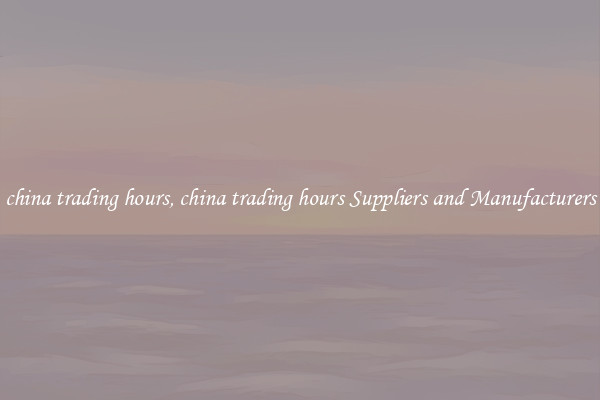china trading hours, china trading hours Suppliers and Manufacturers
China Trading Hours: A Window of Opportunity for Suppliers and Manufacturers

China has long been known as the world's manufacturing hub, producing an extensive range of products for global markets. The country's robust manufacturing sector is fueled by its skilled workforce, cost-effective production capabilities, and reliable infrastructure. However, one crucial aspect that suppliers and manufacturers need to consider is the China trading hours.
China's trading hours refer to the time during which businesses operate, and it is essential to understand these hours to ensure seamless communication, coordination, and timely delivery. Generally, China follows the standard Beijing Time, which is eight hours ahead of Greenwich Mean Time (GMT+8). However, it is crucial to note that China does not observe daylight saving time, resulting in consistent trading hours throughout the year.
China's trading hours typically start at 9:30 am Beijing Time and continue until 11:30 am, known as the morning trading session. After a two-hour lunch break, the afternoon trading session begins at 1:00 pm and lasts until 3:00 pm. These trading hours apply to the Shenzhen and Shanghai stock exchanges and are indeed critical for investors and traders.
For international suppliers and manufacturers, understanding China's trading hours allows efficient communication with local partners and enhances productivity. It ensures that timely queries, product updates, and order placements can be made during the appropriate trading hours, minimizing delays and optimizing business operations.
Moreover, knowledge of trading hours is particularly crucial for time-sensitive industries that require real-time coordination. For example, if a manufacturer in another country wants to consult with their Chinese counterpart regarding production timelines, quality control, or shipping arrangements, it is essential to be cognizant of the time difference to avoid unnecessary delays.
In addition to understanding trading hours, suppliers and manufacturers should also be aware of holidays and unofficial breaks in China. The most significant holiday is the Chinese New Year, also known as the Spring Festival, which lasts approximately two weeks. This holiday significantly affects business operations, and many manufacturers and suppliers shut down entirely during this period. Understanding these holiday periods is key for effectively planning production, orders, and shipments to avoid setbacks or stockouts.
To navigate Chinese trading hours effectively, various digital tools are available to facilitate communication and bridge time differences. For instance, global businesses often utilize online collaboration platforms, video conferencing apps, and instant messaging services to communicate with their Chinese partners in real time. Additionally, proactive scheduling and setting clear expectations for responses and communication turnaround time are vital to ensure smooth operations.
China's trading hours may initially seem like a logistical challenge for international suppliers and manufacturers; however, understanding and adapting to this time difference opens up a world of opportunity. With effective planning and the right tools, businesses can maximize their engagement with Chinese partners and leverage the country's manufacturing capabilities.
In conclusion, China's trading hours are crucial for suppliers and manufacturers looking to conduct business efficiently and effectively. By aligning with these trading hours, businesses can optimize communication, minimize delays, and forge strong relationships with their Chinese counterparts. With careful planning and the use of digital tools, the time difference becomes an opportunity rather than a hindrance, allowing global businesses to tap into China's vast manufacturing capabilities.

View details

View details

View details

View details








